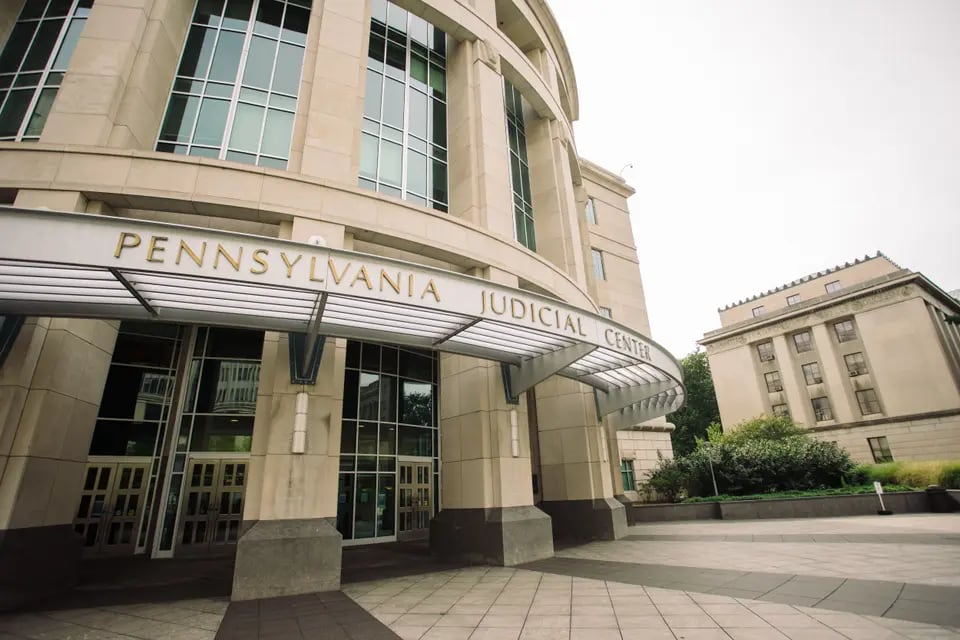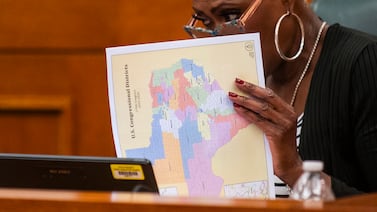This article is part of a yearlong reporting project focused on redistricting and gerrymandering in Pennsylvania. It is made possible by the support of Spotlight PA members and Votebeat, a project focused on election integrity and voting access.
HARRISBURG — An appellate judge has recommended the Pennsylvania Supreme Court adopt the congressional map passed by the Republican-controlled General Assembly and rejected by Gov. Tom Wolf, citing its legislative approval and how it reflects the GOP’s geographic advantage.
Commonwealth Court Judge Patricia McCullough selected the map from among more than a dozen proposals submitted by Wolf, top legislative leaders, citizen groups, and others as part of an ongoing lawsuit over the highly consequential district lines.
McCullough was set to pick a final map before the state Supreme Court accepted a request to take over the process, and asked her to instead make a recommendation. The high court is not required to follow McCullough’s counsel as it prepares to hold hearings on the map. The justices can pick one of the proposals, alter them, or draw a different map.
Pennsylvania must draw new district lines every 10 years to reflect population changes. Because of the state’s sluggish growth in the 2010s, it will lose one of its 18 congressional seats.
Wolf, a Democrat, vetoed the Republican map in January, calling it “highly skewed.” While it does fulfill base, neutral criteria outlined in a previous ruling by the state Supreme Court, the map does not reflect the partisan composition of the state, nonpartisan analyses show.
The map was originally drawn by Amanda Holt, a noted redistricting advocate and former Republican Lehigh County commissioner, and championed by state Rep. Seth Grove (R., York). The original map was amended after Republican members of the House State Government Committee, the panel that first considered the proposal, complained about divisions in their counties.
Anticipating an impasse between Wolf and Republican lawmakers, two groups of Pennsylvanians filed lawsuits in December asking Commonwealth Court to take over the process. The court, in turn, asked the citizen petitioners, Wolf, top Republicans and Democrats, and good-government advocates to submit their own proposed maps.
McCullough, a Republican, presided over two days of hearings on more than a dozen proposals. She cited the House GOP map’s passage through the legislative process as a factor for its selection, writing the interests of the state “would best be served” by considering that the map “is functionally tantamount to the voice and will of the People.”
She also found compelling a Republican argument that the map best reflects the state’s political geography, which favors the GOP because Democrats live clustered in urban areas.
“This map prioritizes the constitutional obligations of creating congressional districts in a nonpartisan way using only data sets that were necessary to create compact and contiguous districts that promote communities of interest and respect Pennsylvania’s natural geography,” House Speaker Bryan Cutler (R., Lancaster) and Majority Leader Kerry Benninghoff (R., Centre) said in a statement.
While the Pennsylvania Constitution has no explicit requirements for the state’s congressional map, the courts have embraced “neutral” criteria like keeping district populations equal and minimizing county and municipal splits. Judges are also using relatively new tests like the efficiency gap — which indicates the number of “wasted votes” in each election or the number of votes that don’t contribute to a candidate’s victory — to consider the “partisan fairness” of a map.
“I think it’s a reading that places more value on land than it does on people,” said Justin Villere — executive director of Draw the Lines PA, a project of the good-government group Committee of Seventy — of McCullough’s ruling.
“To say that there is inherent bias that we have to live with is antithetical to the idea of fair elections which states people are the ones who are electing their leaders, not necessarily determined by how the voting population is dispersed.”
After initially declining to take over the process, the state Supreme Court, which has a Democratic majority, in early February accepted a request from some of the original petitioners to select the final map as Pennsylvania fast approaches deadlines for the May primary.
Candidates can begin circulating nominating petitioners on Feb. 15, however, they will likely begin doing so without finalized districts. McCullough recommended moving the start date to March 1.
The Pennsylvania Supreme Court will begin hearing oral arguments Feb. 18.






